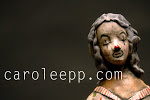
What seems like a long, long time ago as an undergrad student I ran across the work of Scott Rench in an issue of Ceramics Technical and was blown away by his silkscreening technique of getting imagery onto clay. Before leaving school I got a crash course, literally an hour or so, on how to expose a screen and then I was off and running. Well not really. I quickly discovered how difficult it was to properly expose a screen without the proper equipment and my attempts were admitedly quite pathetic. In the end the direction of my work has lead me down other paths which haven’t required a thorough knowledge of printmaking techniques for clay. But I’m still quite a fan of artists who find the means to eloquently incorporate two dimensional imagery into three dimensional (or two dimensional) clay.
Scott Rench’s art has changed quite a bit since I first ran across his work. But his interest in combining new technology and the computer in his process has been a constant. It’s an interesting mix to take such a tactile maliable material that has such a long history and to combine it with new technology that changes quicker than most of us can keep up with and which is also so dramatically different than working in clay, your maliable material being pixels, zeros and ones.
But I think more and more the computer is invading the studio, either as a tool at our disposal for sketching and developing ideas, for manipulating imagery, for accounting and marketing, recording, storing digital images of our work, and for branching out, communicating with and developing our community. The more I think about it the more I realize that I would be as lost without my computer as I would be without my kiln.
In a more recent series of pieces Scott has worked directly with imagery taken from the computer itself and incorporated with other symbolic imagery to create sometimes complex and other times straight to the point statements about contemporary culture.
Check out the Dubhe Carreno Gallery for more images of Scott’s and other great ceramic artists.
Recently Lark Books also published a book on Print and Ceramics. I have yet to get a copy, but have had a good browse at the book and it looks great. As always Lark fills it with yummy full color photos and the work they’ve chosen is really exciting and contemporary. Lots of different techniques are covered.
But of course the printmaking bible to me will always be Paul Scott’s book Ceramics and Print.
A few years back I while I was still a student in Australia I got the amazing opportunity to volunteer with the ANU’s Distance Ceramics Program (an amazing program for artists who want to work part time yet still acquire a degree – I’ll post more info in a later blog.) Paul Scott was one of the instructors for that particular distance school and I got to sit in on the workshop. While I had read his book prior to that, it was amazing to see the techniques first hand and many techniques which had seemed complex became quite straight forward it the end. Beyond that Paul was an amazingly talented, hilariously funny and generous artist, willing to share all of his trade secrets. And the poignant nature of his subversive work has always interested me.
There is a quote from Paul Scott’s catalogue Remember me when this you see which I returned to quite a bit when working on my thesis work with the figurine sculptures. It spoke to what I was trying to accomplish through my own work, the feeling that we are an intricate part of the greater narrative at all times, whether we are aware of it or not. It says:
“I like to make work that provokes some reaction or thought, work that is more than superficial. The issues I deal with are the ones I come across in my everyday life, sometimes close to home, like foot and mouth, or Sellafield, sometimes further away like Israeli bombing of refugee camps, or US treatment of prisoners. But even these far away issues are close to home because we buy Israeli fruit and veg in our supermarkets, we are or can be complicit in these things. I want people to think…”(Dahn, Jo. Remember me when this you se. Ceramics by Paul Scott and from the University of Wales, Aberystwyth and Cereddigion Museum Catalogue Essay.)
Another great site to check out for interesting work with print and ceramics is Robert Dawson’s Website Aesthetic Sabotage (I love the name!). It contains great work with traditional ceramic print imagery manipulated for a contemporary context.














thank you so much for the informative posts. I love to expirament with clay, I just bought a gocco to try to print imagery on clay. But it still is in the closet becuase I have so many other ideas too…clay just does that to me! I am so happy to get my hands back into clay!
Awesome products, I specially liked the plate on the last picture, very original.